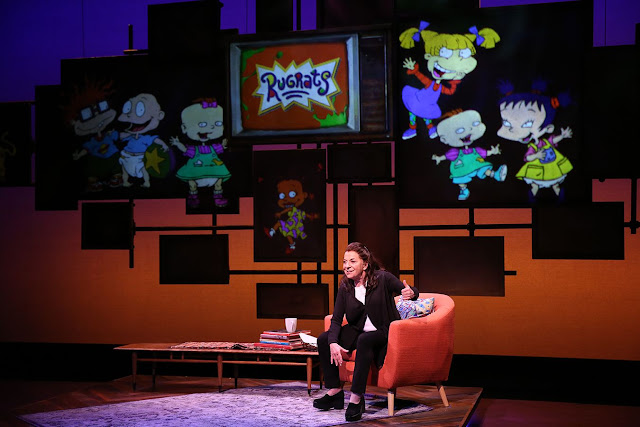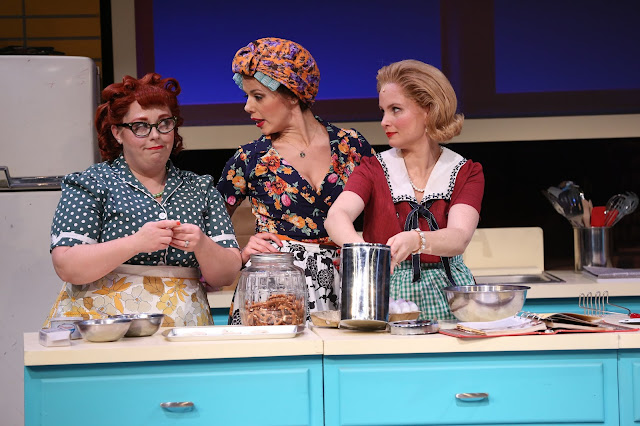“Shticking It to the Man”
 |
| Stars range from 5-1. |
First, a little theatre history: commedia dell’arte was a widely popular genre of Italian comic theatre that flourished between the 15th and 18th centuries, touring all over Europe and influencing playwrights everywhere, including Shakespeare and Molière. It was based on scenarios rather than set scripts, allowing its easily recognizable stock characters to improvise their lines and use conventional stage business (lazzi) along with memorized speeches, comic as well as poetic, which could be inserted on the spot as needed. The characters had variations and different names from company to company over the years, but their general outlines remained more or less the same.
 |
| Company of The Servant of Two Masters. Photo: Gerry Goodstein. |
By the 18th century,
commedia was dying but a couple of brilliant but rival Venetian playwrights, Carlo Gozzi and Carlo Goldoni, tried halting its demise by writing for the genre. One of the most successful results was Goldoni’s masterpiece,
The Servant of Two Masters (Il Servitore di due Padroni). Its first version allowed for considerable improvisation by star Antonio Sacchi; however, as the playwright became disillusioned with the excesses committed by
commedia actors, it evolved by 1753 into a fully scripted comedy of manners, albeit with many of Sacchi’s inspirations still in place.
 |
| Liam Craig, Steven Epp. Photo: Gerry Goodstein. |
In 2011, the frequently revived, translated, and adapted play—very rarely seen in New York, though—received a modern dress, Anglicized version by Richard Bean, One Man, Two Guvnors, that opened at London’s National Theatre and then became a Broadway hit, making a star of James Corden.
 |
| Steven Epp, Allen Gilmore. Photo: Gerry Goodstein. |
The beautifully performed, cleverly staged, attractively designed but somewhat hollow rendition now being offered at Brooklyn’s Polonsky Shakespeare Center, home of Theatre for a New Audience, is by Constance Congdon; it has “further” adapted features by its inventive director, Christopher Bayes, and its excellent leading actor, Steven Epp, based on a translation by Christina Sibul. It arrives after several previous iterations, the most immediate in Washington, D.C.
 |
| Orlando Pabotoy, Liz Wisan. Photo: Gerry Goodstein. |
Goldoni’s title refers to Truffaldino (Epp), the clever but foolish, greedy yet lovable troublemaker who serves the beauteous Beatrice (Liz Wisan), who’s disguised herself as her dead brother, Federigo. Seeing a chance to further feed his belly, Truffaldino also takes service with Florindo (Orlando Pabatoy). Beatrice, wanting to marry Florindo, of whose presence she’s unaware, needs the dowry money her brother would have been given had he lived to marry Pantalone’s (Allen Gilmore) daughter, Clarice (Adina Verson), now betrothed to Silvio (Eugene Ma), chubby son of Dottore (Andy Grotelueschen).
Multiple romantic complications arise from Truffaldino’s double service. These are unraveled, the various lovers, including Truffaldino and Smeraldina (Emily Young), Clarice’s servant, are successfully coupled, and everyone goes home happy.
 |
| Liz Wisan, Eugene Ma. Photo: Gerry Goodstein. |
Bayes’s approach is to return The Servant to its improvisatory roots and to recapture the wild zaniness and madcap, anything-goes excitement of commedia as it might have been performed in its heyday, as seen in Renaissance illustrations of its capering, caricaturish characters. But everything here is so carefully calibrated that there seems little room for real improvisation. Comparing its street-theatre style to the theatrical illustrations of Goldoni’s own day, as in the art of Pietro Longhi, where elegance predominates, is like comparing apples to oranges.
 |
| Liam Craig, Steven Epp. Photo: Gerry Goodstein. |
Imagine a company of clowns in the tradition of the Marx Brothers, the Three Stooges, Abbott and Costello, Charlie Chaplin, Carol Burnett, Martha Raye, and Lucille Ball, all performing at high energy with every move perfectly choreographed, and every line accompanied by a preplanned piece of shtick, such as musical punctuation, double and triple takes, or pratfalls, and you’ll get an idea of what’s in store. It’s the kind of show in which a hand never meets a face it doesn’t slap (cue the drum!).
 |
| Allen Gilmore, Liam Craig, Adina Verson, Eugene Ma, Emily Young, Andy Groteleuschen. Photo: Henry Grossman. |
Bayes has assembled a versatile, agile band of mugging mummers, who can also make beautiful music when they sing. All excel, but Epps, even with his face hidden by his black mask, rules because of his limber physicality and the amusing flexibility of his nifty responses to every threat. He’s particularly memorable in the play’s famous banquet scene as he catches food on a tray as it goes flying through the air.
 |
| Company of The Servant of Two Masters. Photo: Henry Grossman. |
Katherine Akiko Day’s attractive set converts the flexible space into an old-time proscenium theatre on whose wood-planked, footlit floor is placed a traditional booth stage, dominated by a washed-out looking half-curtain, whose constant swishing open and shut, as well as its being flung into the air, practically makes it another character. Upstage are miniature houses and a blue, cloud-filled sky drop. Chuan-Chi Chan’s lighting—which encases the theatre in Christmas lights—creates enchanting effects.
Most of the classic characters--like the servant Truffaldino (a variation of Arlecchino/Harlequin); another servant, Brighella (Liam Craig); the miserly old man, Pantalone; and the pompous pedant, Dottore—wear the half or partial masks seen in classic illustrations, while the others remain unmasked. Valérie Thérèse Bart’s vivid costumes, with a few exceptions, such as Clarice’s exaggerated, steampunk-like getup, with puffy crinolines, are purely traditional, like Truffaldino’s lozenge-patterned tunic and pants.
 |
| Christopher Curtis, Aaron Halva, Liz Wisan. Photo: Henry Grossman. |
Rather than have the actors play their own music, a terrific pair of costumed musician/composers, Christopher Curtis and Aaron Halva, who play multiple instruments, sit at stage right responding with musical reactions to all the business, often being cued for more by the characters themselves.
 |
| Steven Epp. Photo: Gerry Goodstein. |
The lively adaptation, most of it in current-day speech, including scattered vulgarities, is chockablock with contemporary references, many of them of the anti-Trump variety, but also including things like Wikileaks and Cellino & Barnes commercials; and let's not forget the improvisatory byplay with spectators down front. I love the bit when Truffaldino pulls a wall switch, cutting off the lights and saying: “If you pull the wrong lever the world gets plunged into darkness.” Nothing is taken seriously, the audience is considered as a co-conspirator, and the jokiness is never-ending. And therein lies the problem.
 |
| Steven Epp, Allen Gilmore. Photo: Gerry Goodstein. |
Goldoni has, indeed, provided a complexly structured, comedic love plot but, as played here it’s seen as little more than a scenario, a blank wall on which to stick a lot of shtick. Many audience members giggled consistently when I attended, occasionally bursting into a big laugh, but the insistent focus on clowning robs the play of its human element and greatly diminishes its warmer humor. Too many of the characters, for all their masks and costumes, are on the same broad comic wave length, and distinctions among them are only superficial. There’s just so much one can take of stage silliness, no matter how well done.
 |
| Steven Epp, Emily Young. Photo: Gerry Goodstein. |
The show reveals nearly all its cards in act one, leaving little to anticipate theatrically in act two. The second act, however, which is slightly less frenetic, is actually funnier, and even a bit more human than the first. Nonetheless, when it ends, after two and a half hours, you may feel, with me, that it’s overstayed its welcome by an hour.
 |
| Company of The Servant of Two Masters. Photo: Gerry Goodstein. |
OTHER VIEWPOINTS:
Polonsky Shakespeare Center/Theatre for a New Audience
262 Ashland Place, Brooklyn, NY
Through December 4


 When I go to a show called Not That Jewish I expect to laugh a lot, which, in fact, I did at this engaging one-woman show by and starring Monica Piper. What I didn’t expect, though, was to find my heartstrings being plucked so tenderly that even the Zyrtec I swallowed that morning couldn’t keep my eyes and nose dry.
When I go to a show called Not That Jewish I expect to laugh a lot, which, in fact, I did at this engaging one-woman show by and starring Monica Piper. What I didn’t expect, though, was to find my heartstrings being plucked so tenderly that even the Zyrtec I swallowed that morning couldn’t keep my eyes and nose dry. 



























































